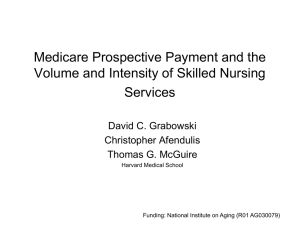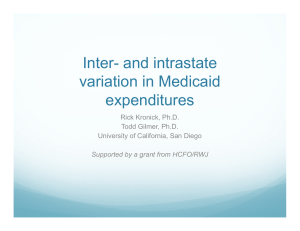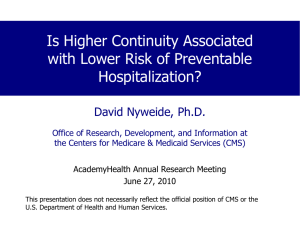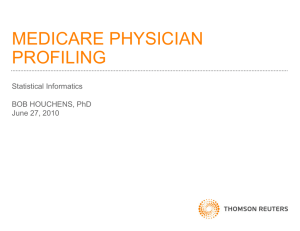Medicare and Health Reform: Implications for Beneficiaries Tricia Neuman, Sc.D. Vice President, Kaiser Family Foundation
advertisement
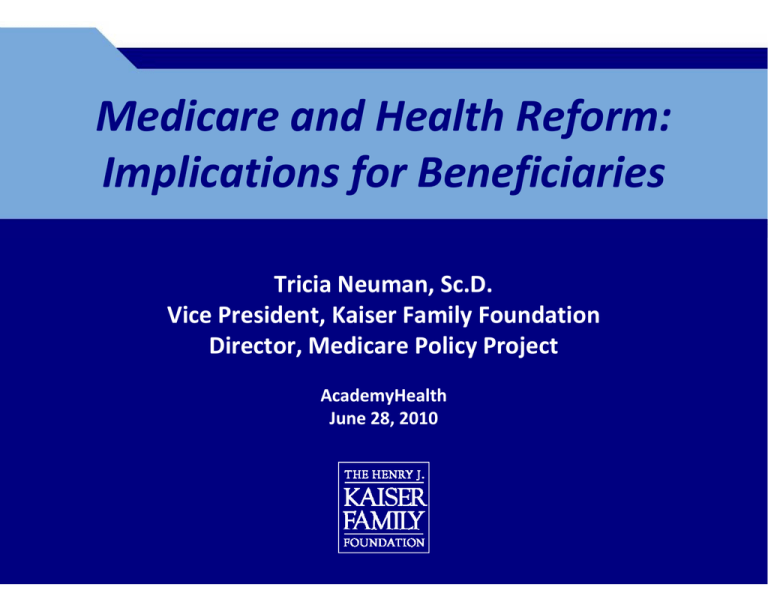
Medicare and Health Reform: Implications for Beneficiaries Tricia Neuman, Sc.D. Vice President, Kaiser Family Foundation Director, Medicare Policy Project AcademyHealth June 28, 2010 Exhibit 1 Net Effect of Major Legislation on Medicare Spending Net Spending/Savings as a Share of Projected Medicare Spending Over 10 Years Net Spending/Savings as a Share of Projected Medicare Spending Over 10 Years BBA BBRA BIPA MMA DRA MIPPA PPACA (1997) (1999) (2000) (2003) (2005) (2008) (2010) $3 4 $3.4 $3 2 $3.2 $3 2 $3.2 $3 8 $3.8 $5 6 $5.6 $6 3 $6.3 $7 1 $7.1 Net spending Net savings 10‐yr Medicare baseline amounts baseline amounts (in $ trillions): Source: Kaiser Family Foundation analysis of Congressional Budget Office (CBO) estimates. Notes: Shares are rounded to the nearest whole number. Net spending as a percent of baseline for MIPPA is rounded up from ‐0.02%; estimate for DRA is rounded from ‐0.47%. Baseline amounts are based on CBO projections of 10‐year Medicare baseline spending prior to enactment of legislation. Health Reform: Medicare Spending Disproportionate Share Hospital 1% Medicare Savings Program/Part D Low‐ Income Subsidies 1% Part D Enrollment/ Consumer Protections 1% Medicare Advantage 1% • $105 billion in Medicare spending over 10 years • $43 billion to gradually close the Part D doughnut hole Medicare/ Medicaid Interactions 3% • $8 billion for primary care physicians and other providers • $5 billion for prevention benefits NOTE: No additional spending for physician payments/SGR “fix” Ten‐Year Medicare Spending = $105.3 Billion Source: Kaiser Family Foundation analysis of Congressional Budget Office (CBO) cost estimates as provided on March 20, 2010. EXHIBIT 4 Standard Medicare Prescription Drug Benefit, 2020 p g , Before and After Health Reform Before: 5% paid by enrollee After: 15% paid by plan; 80% paid by Medicare 100% id b 100% paid by enrollee ll Catastrophic coverage Coverage gap 15% paid by plan; 80% paid by Medicare 25% paid by enrollee Brands: 50% discount 25% paid by plan 25% paid by plan Generics: 75% paid by plan Initial coverage limit 25% paid by enrollee 75% 75% paid by plan 100% paid by enrollee 25% paid by enrollee Deductible 75% 75% paid by plan 100% paid by enrollee SOURCE: Kaiser Family Foundation illustration of standard Medicare drug benefit in 2020 under the Patient Protection and Affordable Care Act, as amended by the Health Care and Education Reconciliation Act of 2010. HEALTH REFORM: MEDICARE SAVINGS Health Reform: Medicare Savings Part D Premiums 2% Fraud, Waste, and Abuse 1% Part B Premiums Part B Premiums 5% Sources of Savings Independent Payment Advisory Board 3% Delivery System Pilots‐ 1% Part D Enrollment/ Consumer Protections 1% •Provider payments, including DSH and home health ‐ $219 billion •Medicare Advantage – $136 billion •Income‐related premiums – $36 billion Disproportionate Share Hospital (DSH) Payments 4% Home Health Payments 7% •New Independent Payment Advisory N I d d tP t Ad i Panel – $16 billion •Delivery system reforms and hospital •Delivery system reforms and hospital readmissions – $12 billion TTen‐Year Medicare Savings = Y M di S i $533.1 Billion Source: Kaiser Family Foundation analysis of Congressional Budget Office (CBO) cost estimates as provided on March 20, 2010. Notes: *Savings include interactions with Medicare Advantage and TRICARE; spending includes implementation of Medicare changes, Part D interactions with Medicare Advantage provisions, Part B interactions with Part D provisions, and Medicaid interactions with Medicare Part D provisions. EXHIBIT 6 Medicare Advantage Savings: Implications for Beneficiaries Medicare Advantage Savings: Implications for Beneficiaries Key Provisions • • • Medicare Advantage Penetration Freezes benchmarks for 2011; phases in reductions, based on FFS costs in county Reduces plan’s share of rebate from 75% to 50% for most plans (2012) Provides new bonus and higher rebates to plans receiving high quality ratings (2012) l i i hi h li i ( ) Impact on Beneficiaries • • • • Fewer enrollees (CBO) Fewer extra benefits (CBO) Possibly fewer plans Possible increase in the demand for alternative sources of supplemental coverage 50% or more 40‐49% 30‐39% 20‐29% 10‐19% 0‐9% No enrollees 25% of beneficiaries are enrolled in Medicare Ad t Advantage plans in 2010 l i 2010 EXHIBIT 7 New Independent Payment Advisory Board New Independent Payment Advisory Board • 15 f ll ti 15 full‐time members, appointed by President, confirmed by Senate b i t d b P id t fi db S t • Board required to recommend specific Medicare savings proposals if Medicare spending exceeds target growth rates spending exceeds target growth rates • HHS Secretary required to implement board’s recommended proposals , unless Congress enacts an alternative with equivalent savings – regulations not subject Congress enacts an alternative with equivalent savings regulations not subject to judicial review • Board prohibited from recommending proposals that would ration care, reduce benefits, increase cost‐sharing, or modify benefits, eligibility, premiums, or raise taxes, or reduce payments for certain providers (before 2018) • Board makes recommendations to slow the growth in health care spending outside of Medicare – though these recommendations are not binding • B Beneficiary impact – fi i i t TBD EXHIBIT 8 New Income Related Medicare Premiums New Income‐Related Medicare Premiums • PART B: Freezes income threshold at $85,000/individuals and $170,000/couples through 2019 ‐ $25 billion in Medicare savings – Prior to health reform, income thresholds were indexed to affect a constant share of the Medicare population – In 2010, the income‐related Part B premium ranges from $154.70 to $353.60 per month, depending on income. • PART D: Establishes new income‐related Part D premium, with fixed income thresholds as Part B (2011) – Prior to 2011, no income‐related Part D premium EXHIBIT 9 New Medicare Delivery System and Quality Reforms y y y Implications for Beneficiaries? • New Center for Medicare and Medicaid Innovation (2011) • Delivery System D li S – Shared Savings/Accountable Health Organizations (2012) – Bundle payments for hospital and post‐acute care (2013) Bundle payments for hospital and post‐acute care (2013) – Independence at Home Demonstration (2012) • Hospital‐Related p – Preventable hospitalizations (2012) – Value‐based purchasing for hospitals (2012) – Reduction in payments for hospital‐acquired conditions (2015) • Physician‐Related – Mandatory physician quality reporting program (2015) EXHIBIT 10 Delivery System Reforms: Issues for Beneficiaries Delivery System Reforms: Issues for Beneficiaries • Will reforms reduce unnecessary and unwanted medical treatment? Will ll f d d d d l ? ll reforms improve overall coordination and management of care, support transition services, etc? • Will delivery system reforms discourage providers/organizations from treating high cost high need disadvantaged patients? treating high‐cost, high need, disadvantaged patients? y y • Will delivery systems reforms create incentives for providers/organizations to skimp on care? • Wh What protections will be provided for beneficiaries (choice of ACO; lock‐ i ill b id d f b fi i i ( h i f ACO l k in; access to providers, grievance and appeals, marketing, etc) EXHIBIT 11 Health Reform and Dual Eligibles: Key Issues Health Reform and Dual Eligibles: Key Issues Context • 9 million with Medicare and Medicaid (“dual eligibles”) • High rates of chronic conditions; high rates of hospital, nursing home and Rx • Include disproportionate share of under‐65 disabled, 85+, racial/ethnic minorities / • 36 percent of Medicare spending; 46 percent of Medicaid spending • Current system is fragmented; few incentives to coordinate across programs Health reform law • Federal Coordinated Health Care Office in CMS for dual eligibles • Center for Medicare and Medicaid Innovations tasked with testing innovative payment and service delivery models, such as financing and care for dual eligibles Issues • Variations in capacity across states and programs Implications for benefits, choice of providers, grievance and appeals rights • Implications for benefits, choice of providers, grievance and appeals rights • Fiscal accountability ‐ Medicare dollars EXHIBIT 12 Implications for Medicare Beneficiaries Implications for Medicare Beneficiaries • Numerous provisions directly or indirectly affect coverage and care for people on Medicare – with more certainty around some provisions (e.g. doughnut hole) than others (e.g. accountable care organizations) • Extending the life of the Medicare Part A Trust Fund was not an explicit goal, but clearly important for beneficiaries • Unclear whether provider payment reductions will affect access to care, and quality of care – clearly important to track now and as coverage expansions phase in • Delivery system and payment reforms have potential to reduce spending, coordinate Delivery system and payment reforms have potential to reduce spending coordinate care and improve quality – but these efforts are in early stages • Particular attention should be focused on needs and effects of various reforms on low i income and other disadvantaged populations (and the providers who treat them) d h di d d l i ( d h id h h ) • Important to think through next steps for Medicare and improvements for beneficiaries (in that health reform was not really about Medicare) ( y )
